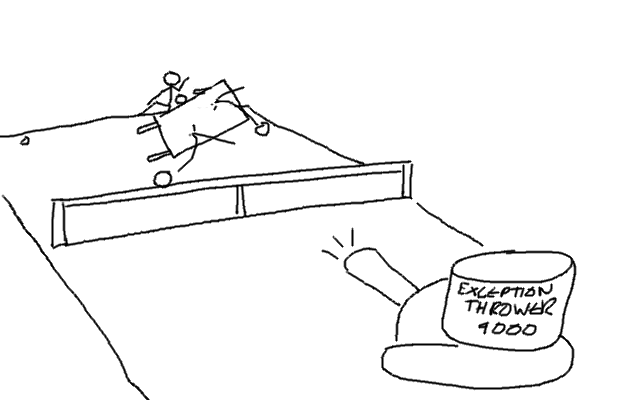The Case for Exceptions Part 2: Putting the Performance Argument to Bed
One criticism levelled against exceptions is that they negatively impact on performance. In this article I will attempt to address this misconception.
The first thing we need to address is what exceptions are for, exceptions are for exceptional circumstances. If exceptions are being used as part of the normal flow of control, or they are being raised frequently by performance critical code then, yes, you probably will see a performance hit. In practice though, exceptions should be raised rarely so the only performance impact we need to consider is the cost of the ability to throw and catch exceptions.

In fact, modern C++ compilers pretty much all implement exceptions using what are called exception handling tables, these “zero cost exceptions” come from the Itanium ABI and are intended to have zero performance impact if no exception is thrown 1.

The oversimplified description of how EH tables work is this: every scope (including implicit scopes) has an entry in the EH table that describes the instructions (whose addresses are known at link time) covered by the scope, the personality routine which essentially maps to some language specific code on how exceptions are handled and a language specific data area, which will be the (again language specific) information on the exception being propagated.
The personality routine then attempts to handle the exception, as part of the handling it may execute a catch block and stop the exception from propagating further, or it might just execute a cleanup routine that forms part of the unwind - for example executing object destructors.
If the routine fails to handle the exception, then the runtime unwinds the stack (most platform ABIs specify how this can be done reliably, at least from a certain set of well defined code locations), looks up the address of the new program counter in the EH table and tries again to handle the exception. This process continues until the exception is handled.
The key point here is that, until an exception is handled, no new instructions are introduced into the normal flow of control to support exceptions. Once an exception is thrown there is a lot of overhead (because we have to do all these lookups in the EH tables), but until that point there should be zero overhead.
If we want, we can actually see what this looks like. Take this simple code snippet:
void perf_function(int i)
{
perf_object o;
o.method(i);
}First, let’s look at the assembly g++ generates without exceptions:
pushq %rbp
movq %rsp, %rbp
movq %rbx, -16(%rbp)
movq %r12, -8(%rbp)
subq $32, %rsp
movl %edi, %r12d
leaq -32(%rbp), %rbx
movq %rbx, %rdi
call __ZN11perf_objectC1Ev
movl %r12d, %esi
movq %rbx, %rdi
call __ZN11perf_object6methodEi
movq %rbx, %rdi
call __ZN11perf_objectD1Ev
movq -16(%rbp), %rbx
movq -8(%rbp), %r12
leave
ret
and now with:
pushq %rbp
movq %rsp, %rbp
movq %rbx, -16(%rbp)
movq %r12, -8(%rbp)
subq $32, %rsp
movl %edi, %ebx
leaq -32(%rbp), %r12
movq %r12, %rdi
call __ZN11perf_objectC1Ev
movl %ebx, %esi
movq %r12, %rdi
call __ZN11perf_object6methodEi
movq %r12, %rdi
call __ZN11perf_objectD1Ev
movq -16(%rbp), %rbx
movq -8(%rbp), %r12
leave
ret
movq %rax, %rbx
movq %r12, %rdi
call __ZN11perf_objectD1Ev
movq %rbx, %rdi
call __Unwind_Resume
Apart from one instance where a different register was selected, the code leading
up to the ret (which represents the normal flow of control) is identical. The
only difference is the addition of a few instructions that will be invoked if
(and only if) an exception is raised. In particular we can see that the new
fragment is responsible for invoking the destructor of o before resuming the
unwind.
One area where exceptions will introduce a penalty is in code size, aside from storing the exception tables we must also generate the cleanup routines for any region of code that might see an exception. The additional data and code can have impacts on instruction and data locality, and potentially trigger more cache misses. Except in extreme cases where space is at a significant premium (such as embedded systems), the additional space required for exception handling is unlikely to introduce a significant performance overhead - it will almost certainly be the case that there are many other inefficiencies to tackle first.
Ultimately it seems that outlawing exceptions purely on performance grounds is an extreme form of premature optimisation. If you believe that exceptions are a useful tool, then you should always favour making them available over their exclusion until you have profile driven evidence that they are causing a performance bottleneck.